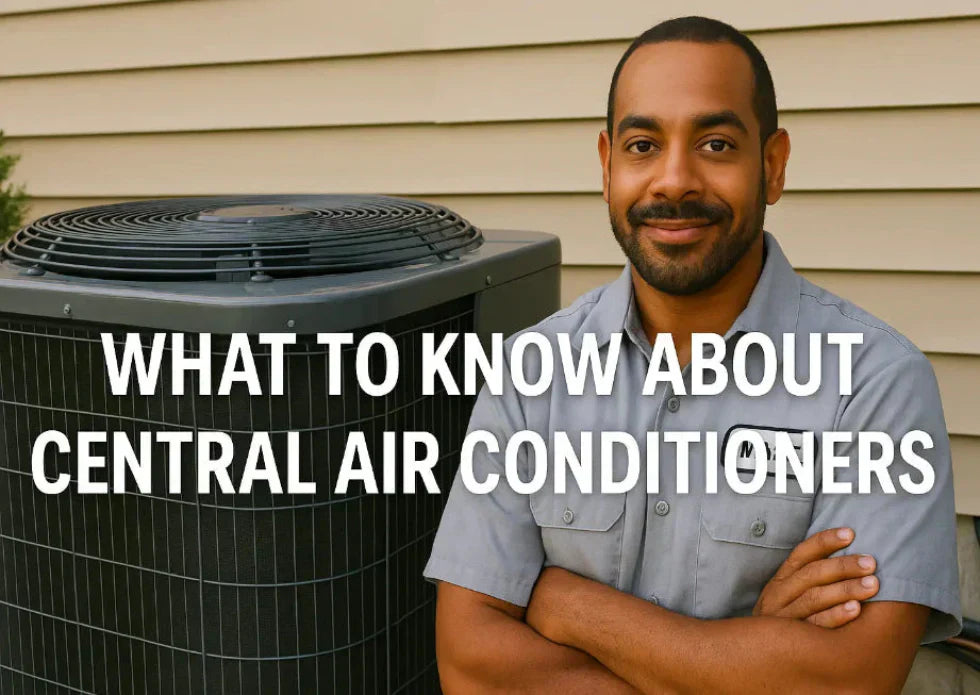🌬️ What Is Central Air Conditioning?
If you’re wondering, what is central air conditioning? Here’s the simplest answer: Central air conditioning is a whole-house cooling system that distributes chilled air through a network of ducts and vents. Unlike a window AC that only cools one room, centralised aircon treats your entire home as a unified space.
When someone asks, what does central air mean?, they’re really looking for a definition that boils down to this: it’s a centralized air conditioning system that lets you control your home’s climate from one central thermostat, providing even, consistent comfort across every room.
❄️ How Does Central Air Conditioning Work?
Next, let’s look at the nuts and bolts — how does central air work? Central AC units operate using a closed-loop refrigerant cycle that absorbs heat indoors and releases it outside. Here’s the breakdown:
✅ How central air conditioning works: The indoor evaporator coil extracts heat and moisture from the air. That warm refrigerant is then pumped outside to the condenser unit.
✅ How does a central AC unit work outdoors? Once outside, the condenser compresses the refrigerant and blows heat into the outdoor air.
✅ How does a central AC unit work inside? Finally, the cooled refrigerant returns inside to repeat the cycle. Throughout this process, the air handler and duct system distribute the chilled air back into your home.
More technical detail is provided by the U.S. Department of Energy, which explores exactly how a central air conditioning system works.
🧭 The Core Components of a Centralized Aircon System
If you want to know what to know about central air conditioners, you need to recognize the main parts that make up your centralised aircon setup:
✅ Condenser Unit (Outdoor): Removes heat and exhausts it outside.
✅ Evaporator Coil (Indoor): Cools the air as it passes through.
✅ Air Handler/Fan: Pushes the cooled air through your ducts.
✅ Ductwork: The network that delivers cooled air to each room.
✅ Thermostat: Your control center — this is what lets you set the temperature.
And that’s the gist of how central air conditioning works! Knowing these pieces also helps you troubleshoot when something goes wrong.
For a clear, easy-to-understand explanation of how all these parts work together, check out this detailed guide on how air conditioning works, which breaks down the process step-by-step in homeowner-friendly language.
🔧 The Different Types of Central AC Units
There are several types of central AC units available to fit different home designs and energy-efficiency goals:
👉 Split-System Central AC:
This is the most common. It has an outdoor condenser and an indoor evaporator coil connected to your furnace or air handler. Perfect for existing homes with ductwork.
👉 Packaged Central AC:
A self-contained unit that houses all components outdoors — often installed on the roof or slab. Great for homes without a basement or attic.
👉 Heat Pumps:
Heat pumps can both heat and cool your home efficiently, making them a popular all-in-one option. Instead of generating heat, they transfer it.
👉 Ductless Mini-Split Systems:
Though not “central,” they can mimic a centralized system for small spaces or new additions without ductwork.
For a comprehensive overview of the types of central air conditioning systems and guidance on which might be right for your home, the Energy.gov guide to central air conditioning is an excellent resource that breaks down each system in homeowner-friendly terms.
🧠 Factors to Consider When Choosing a Central Air Conditioner
When people search what to know about central air conditioners, they usually want a practical checklist before buying. Here are a few key factors:
✅ Home Size:
Your AC must be properly sized — too big and it wastes energy; too small and it won’t keep up. Factors like insulation and window placement matter too.
✅ Efficiency Rating:
Look for SEER2 ratings — the higher the number, the more efficient the unit. This will help you save money long-term.
✅ Installation:
Proper installation is critical. Even a top-notch unit will underperform if installed incorrectly. Always choose a qualified HVAC contractor.
✅ Maintenance:
Get in the habit of regular filter changes and seasonal tune-ups to keep everything running efficiently.
✅ Budget:
Include installation costs and potential utility rebates. Many states offer incentives for upgrading to high-efficiency central AC systems — you can check available rebates at Energy.gov.
🔌 Mark’s Plug & Play Recap
Your central air conditioning system is the heart of your home’s comfort. Understanding what central air is, how a central air conditioning unit works, and what types of central AC systems exist is key to making a smart choice.
Whether you’re shopping for a new unit, wondering what does central air mean, or ready to take better care of your existing setup, the right knowledge pays off — in energy savings, longevity, and most importantly, a comfortable home for you and your family.
And remember, if you’d like more help choosing the perfect unit for your home, don’t hesitate to check out my Complete Guide to a 2 ½ Ton Air Conditioner to help you get started.
Here’s to hassle-free cooling and worry-free wiring.
❄️ — Mark







